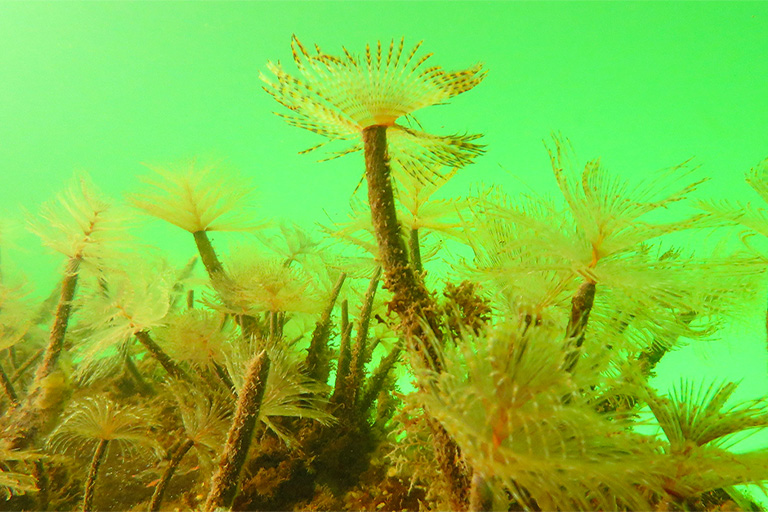Mediterranean fanworm is a threat to marine biodiversity in Canterbury and around the country.
Often between 10–50cm long, the Mediterranean fanworm lives inside a leathery, flexible tube that is brown or grey in appearance. It has feathery filaments that extend out, creating a spiral fan-shape to collect plankton. The fan is banded orange, purple or white, and reaches up to 15cm in diameter.
They often attach themselves to solid structures like wharves and vessels, or other marine creatures like oysters and mussels.
Environment Canterbury considers Mediterranean fanworm to be one of the three main marine biosecurity threats in the region.
Where has Mediterranean fanworm been found in Canterbury?
Environment Canterbury monitors all four ports in Canterbury (Lyttelton, Timaru, Akaroa, and Kaikōura) for marine pests, and fanworm has only been detected in Lyttelton port.
Where is the Mediterranean fanworm in Whakaraupō/Lyttelton Harbour?
Since 2008, fanworm have been found within the inner harbour. Twice a year, NIWA staff monitor and remove fanworm from the harbour to keep their numbers under control, as part of the Biosecurity New Zealand National Marine High Risk Site Surveillance programme.
Recently, small numbers of fanworm have been found outside of the inner harbour – in Cass and Corsair Bays.
Why is it a problem?
Mediterranean fanworm form dense colonies of up to 1000 worms per square metre, competing for food and smothering native species. Their tubes also attach themselves to aquaculture equipment or vessels and can cause damage by clogging motors, pipes or propellers.
John Kottier, Programme Manager for Kaimahi for Nature and Rāpaki Tangata Tiaki, says the spread of Mediterranean fanworm to the outer harbour could also have an economic impact and affect our communities being able to enjoy the harbour.
“It could also affect our mahinga kai resources that have sustained families and communities for centuries. Fortunately, we have Whaka Ora Healthy Harbour, a partnership between Te Hapū o Ngāti Wheke, Te Rūnanga o Ngāi Tahu, Lyttelton Port Company, Environment Canterbury and the Christchurch City Council, focused on improving the environment of Whakaraupō and its surrounds for the benefit of all.”
What should people do if they identify Mediterranean fanworm?
- If you identify Mediterranean fanworm or any other marine pests in the Canterbury region, please log it on the Find-a-pest app or call Environment Canterbury on 03 365 3828 or the Ministry for Primary Industries on 0800 80 99 66.
- Note the location and grab a photo if you can.
- Do not attempt to remove or disturb fanworm as incorrect removal can result in further spreading. There is also a native fanworm in Whakaraupō that looks similar to Mediterranean fanworm.
What containment or elimination efforts have been made?
In 2020, it was identified that numbers of fanworm in the inner harbour were increasing. Environment Canterbury and Lyttelton Port Company undertook further surveillance and removal to get those numbers down. Environment Canterbury now has a separate surveillance programme in place.
Environment Canterbury is also planning a delimiting survey to see how far Mediterranean fanworm has spread outside the Whakaraupō inner harbour, and this will help inform what further action is required.
Environment Canterbury, Ngāti Wheke and Biosecurity New Zealand are also all working in partnership to look at what other approaches we can take and sharing any data that we are able to obtain through surveys undertaken.
How can we stop the spread of Mediterranean fanworm?
Kottier says, “We believe a collaborative solution is required. The Whaka Ora Healthy Harbour partners are working closely with Biosecurity NZ and local organisations such as the Naval Point club, as well as our harbour communities to find immediate solutions to limit the spread of Mediterranean fanworm, through education and clean-up work. But ultimately, what we need is to have regulation in place around a clean hull policy to ensure boat operators and owners keep their hulls clean to stop the spread of invasive species such as Mediterranean fanworm being transferred out of the harbour to other bays and harbours around the peninsula and further afield.”
You can help protect Canterbury’s beautiful waterways and marine ecosystems by being a good boatie and keeping a clean hull.
Top tips for boaties:
- Limiting the fouling on your hull stops pests from catching a ride with you into uncontaminated areas or transferring from your vessel to others when moored or berthed in a marina. Keeping your vessel in good shape will also improve its fuel economy and speed.
- If you intend on travelling to or from another region, please ensure that you check your hull before you leave Canterbury waters and it is pest free.
- When cleaning your hull, do it right. Taking shortcuts can make the problem much worse.
Photo credit: Chris Woods.






